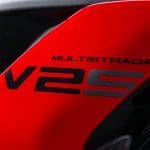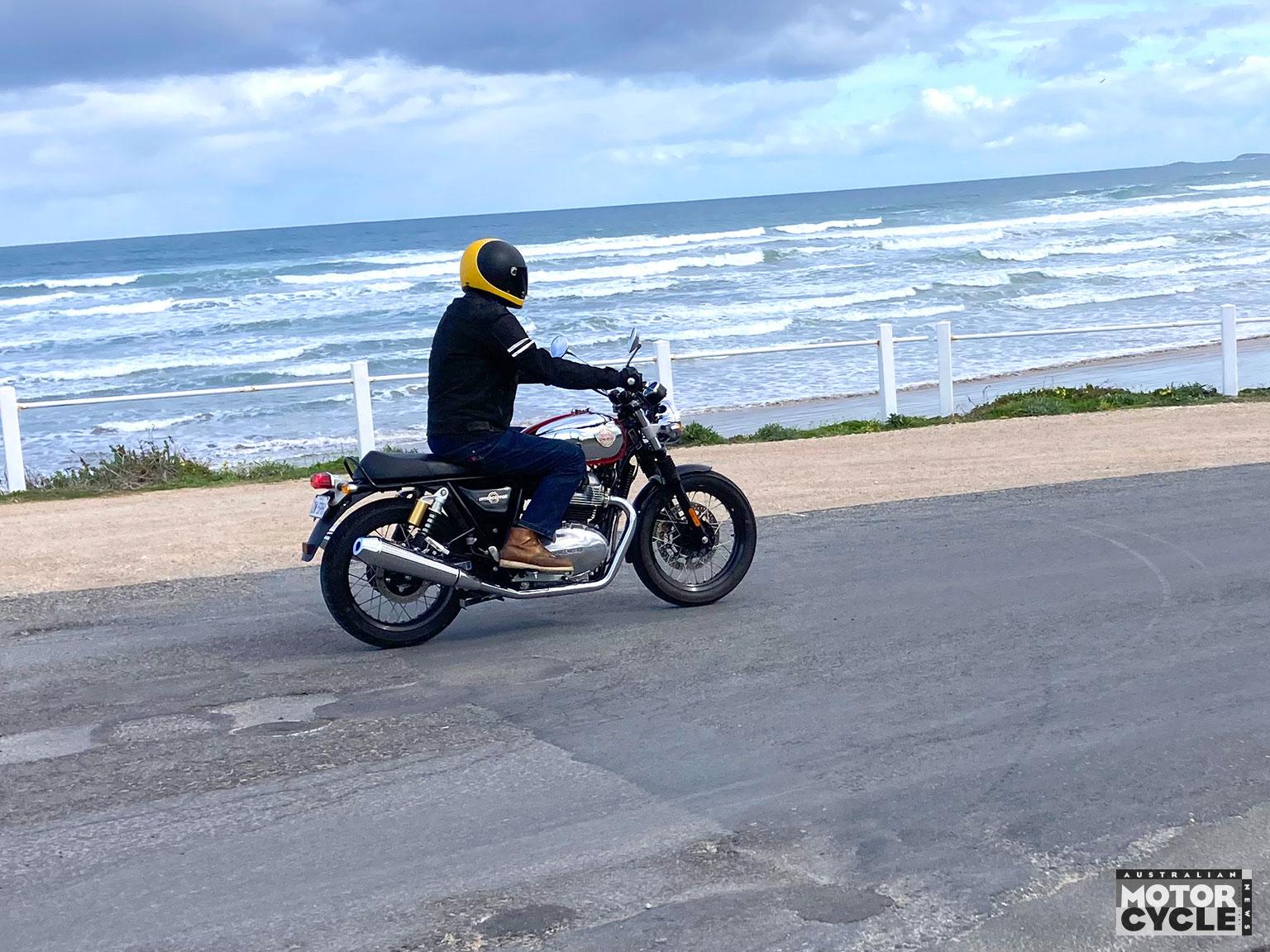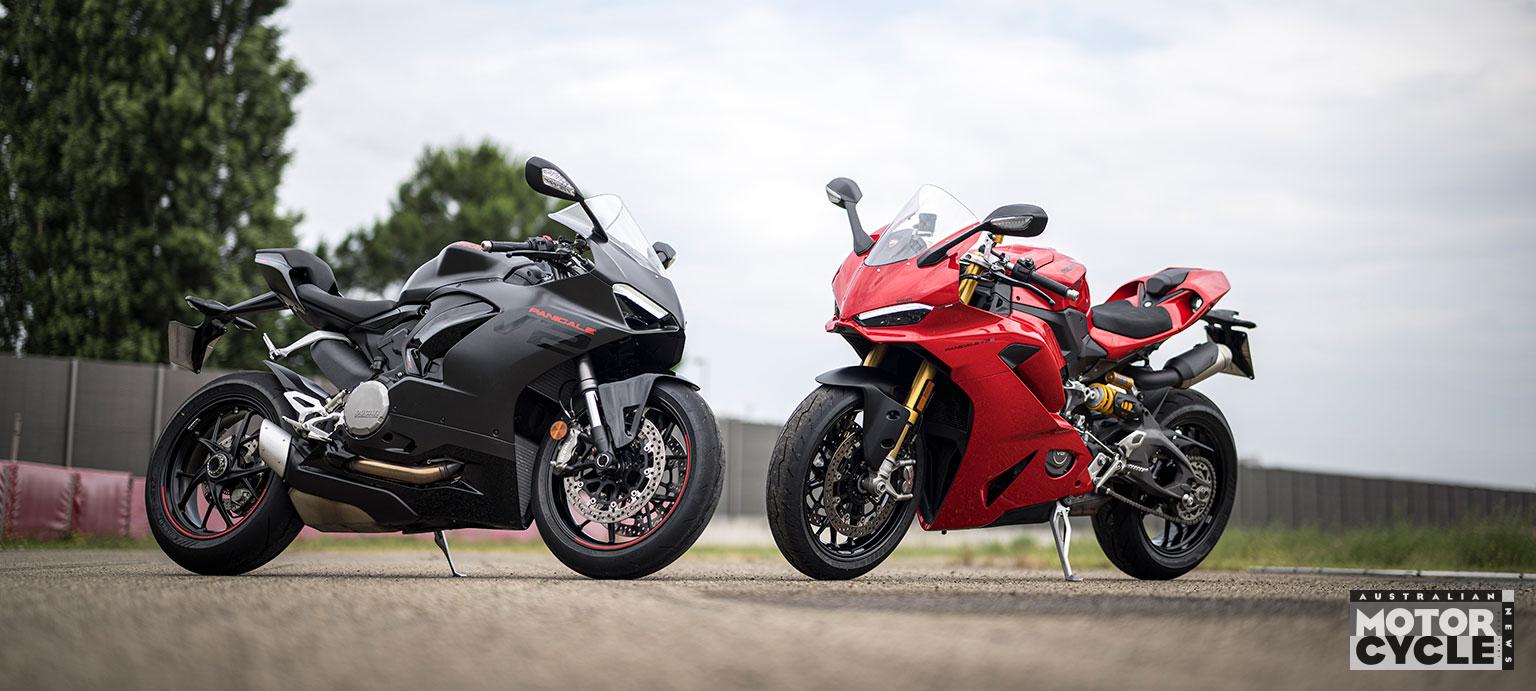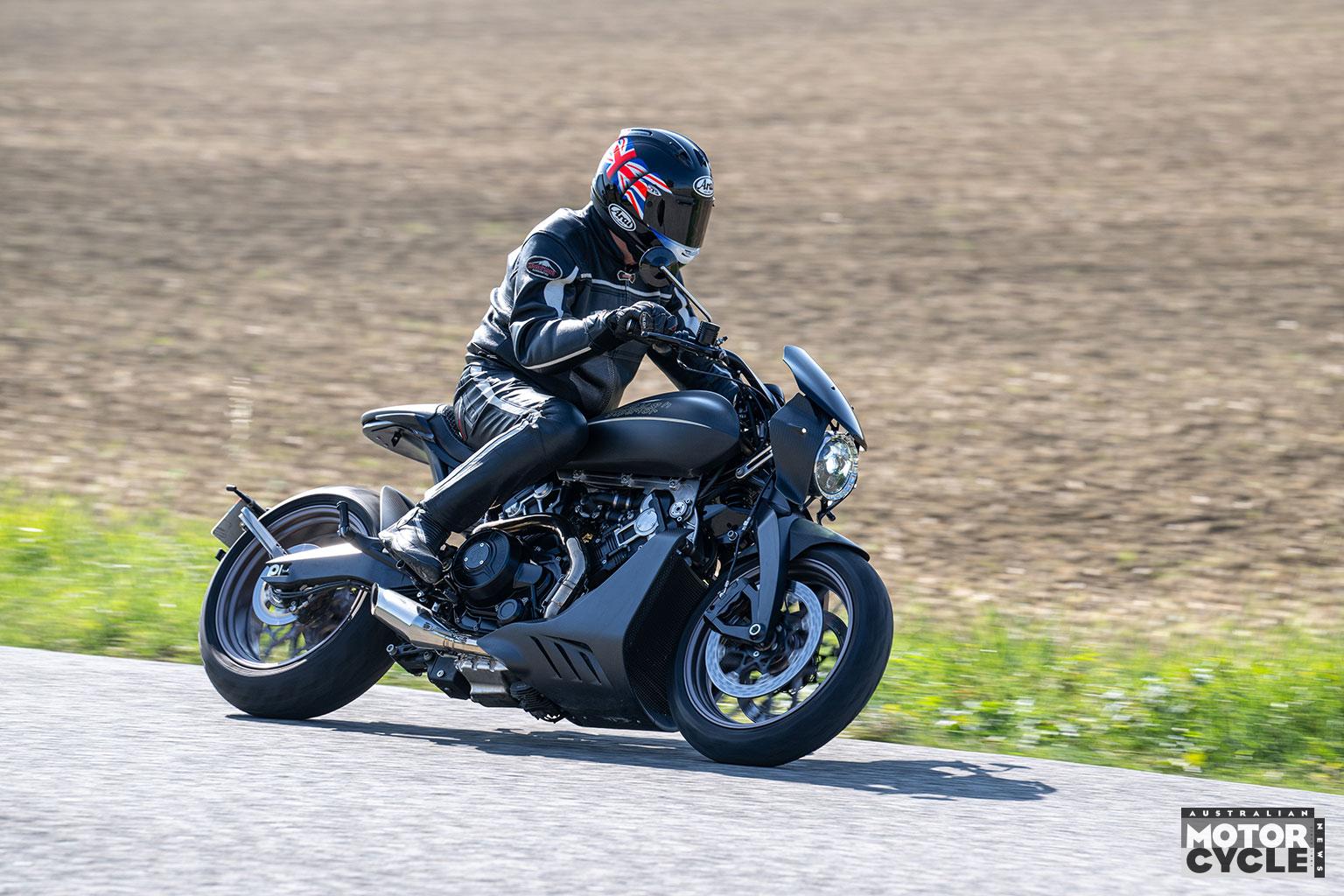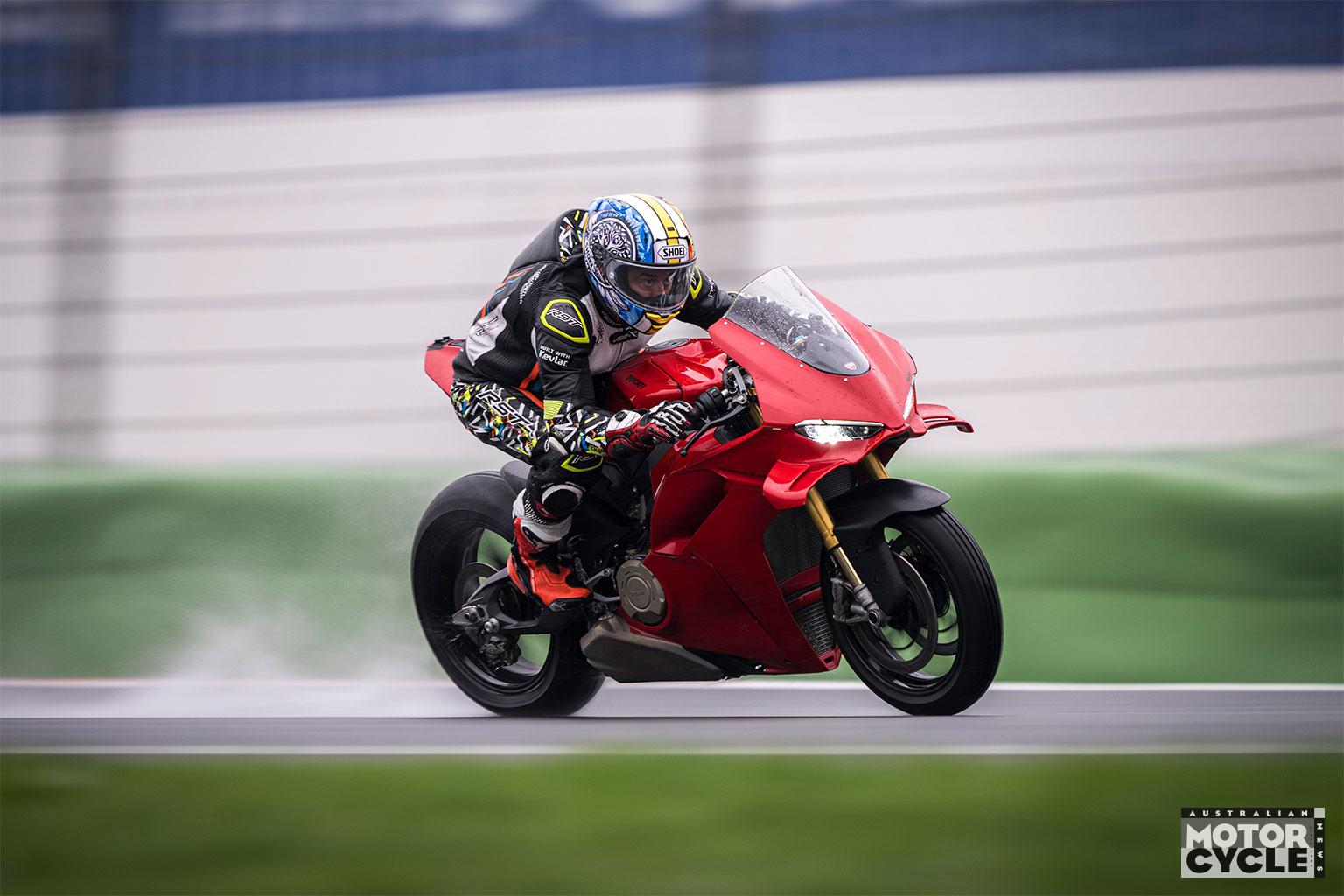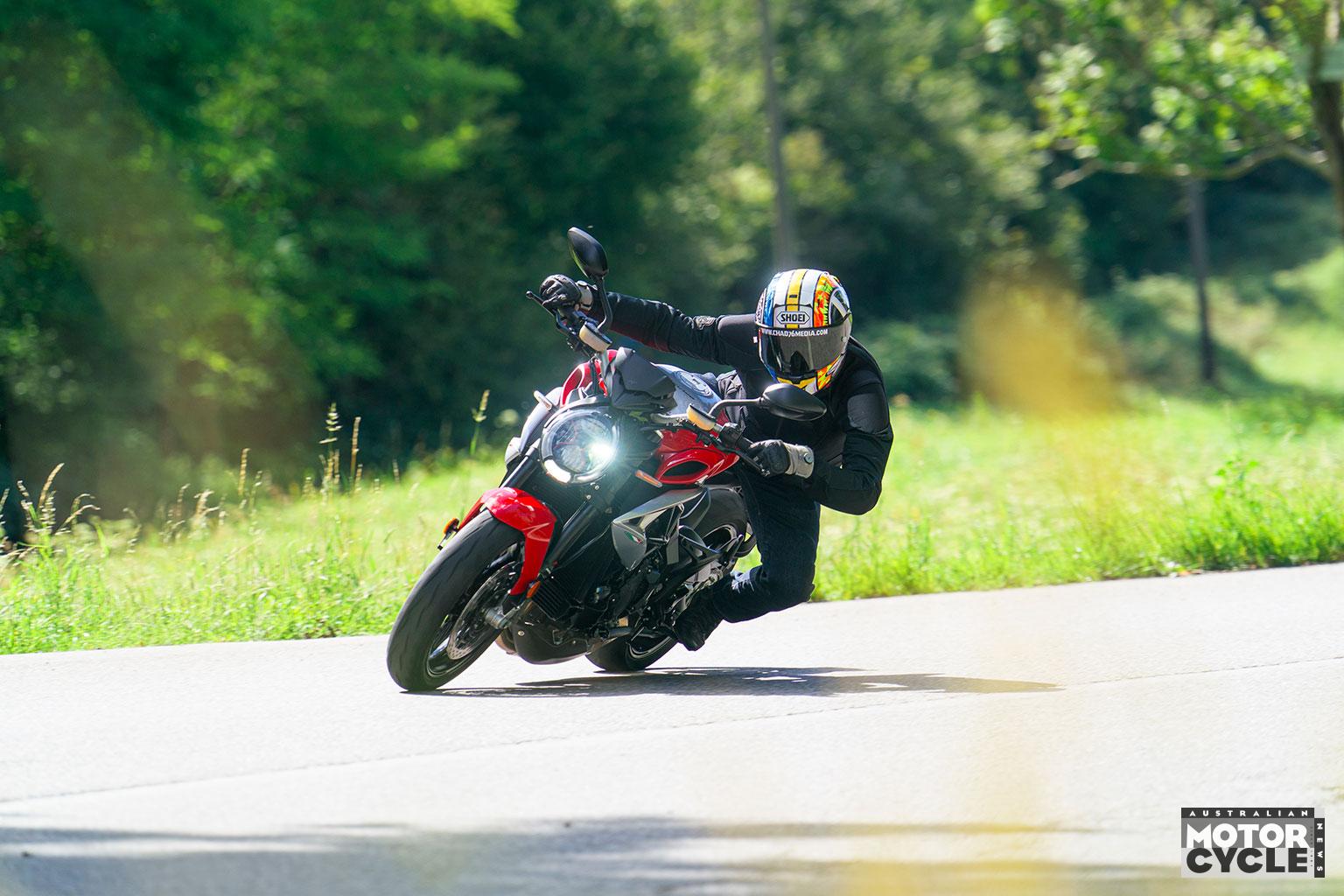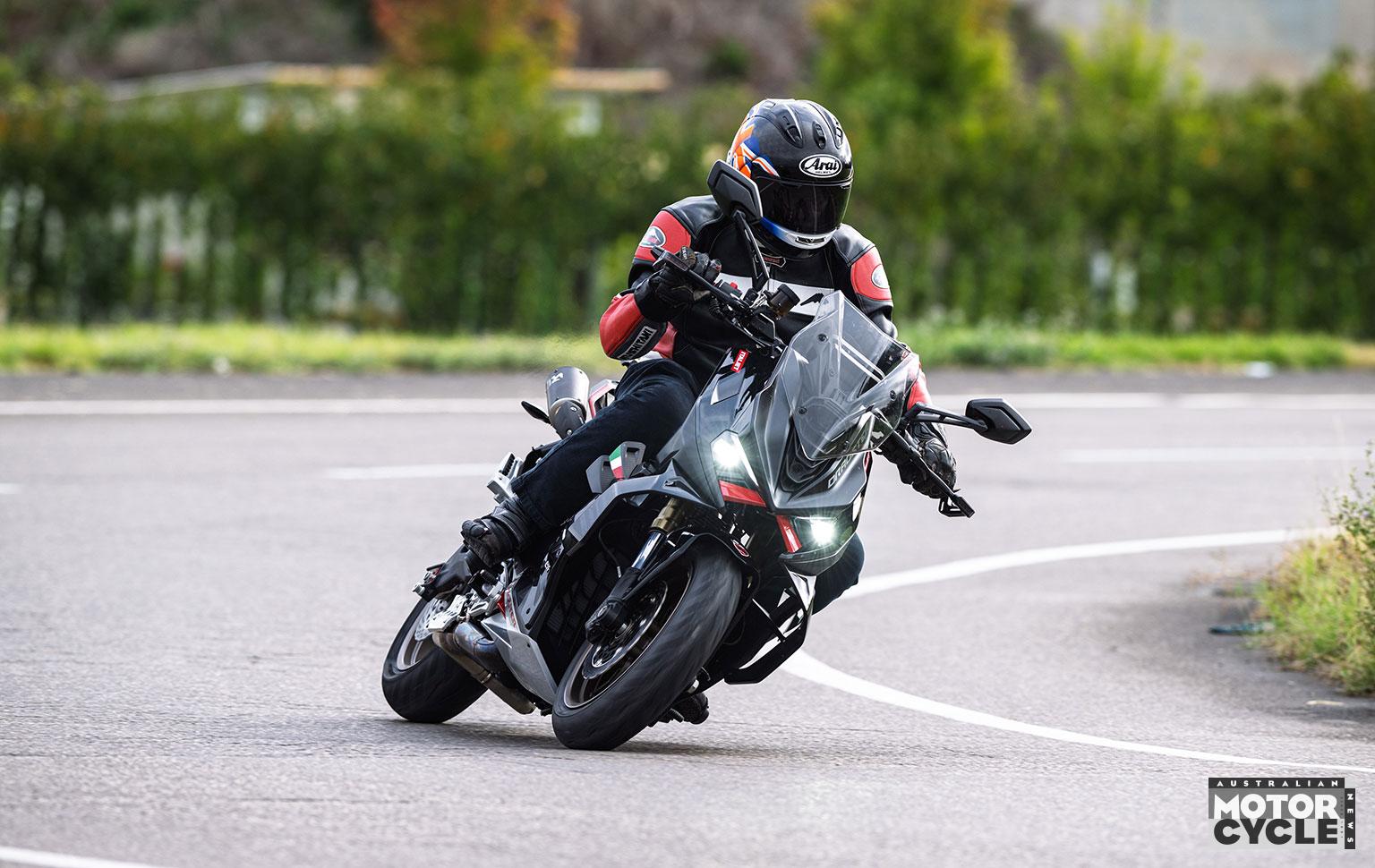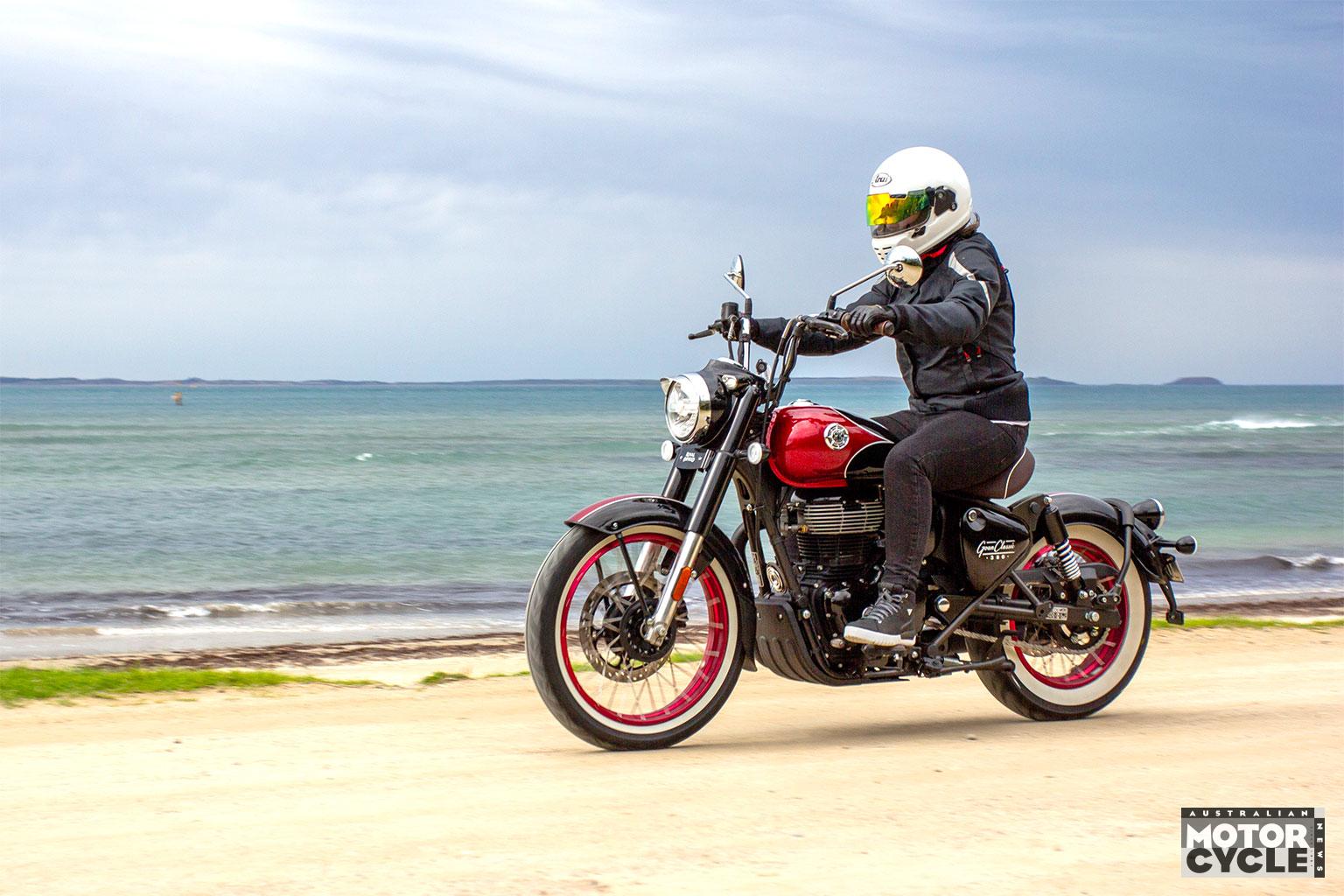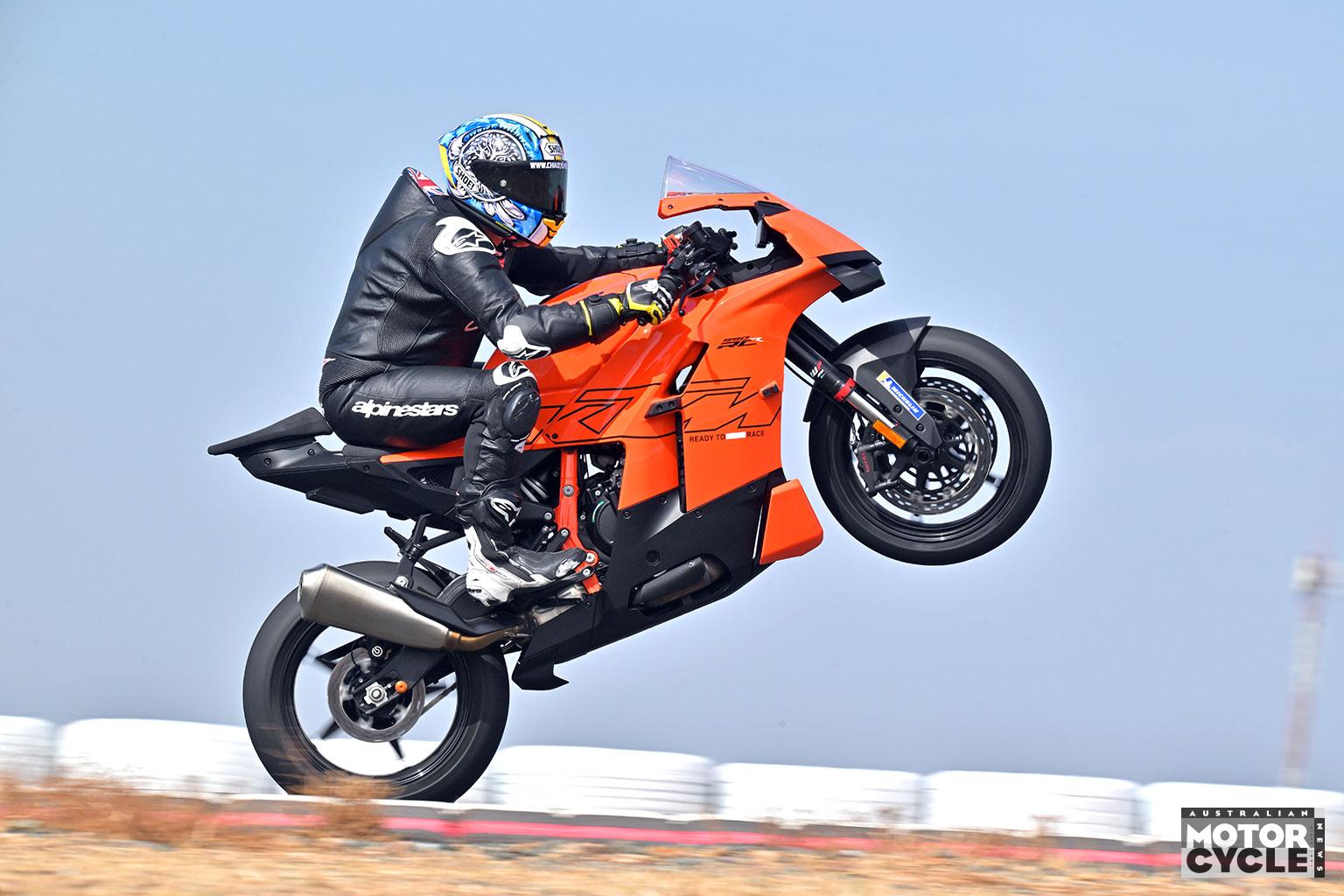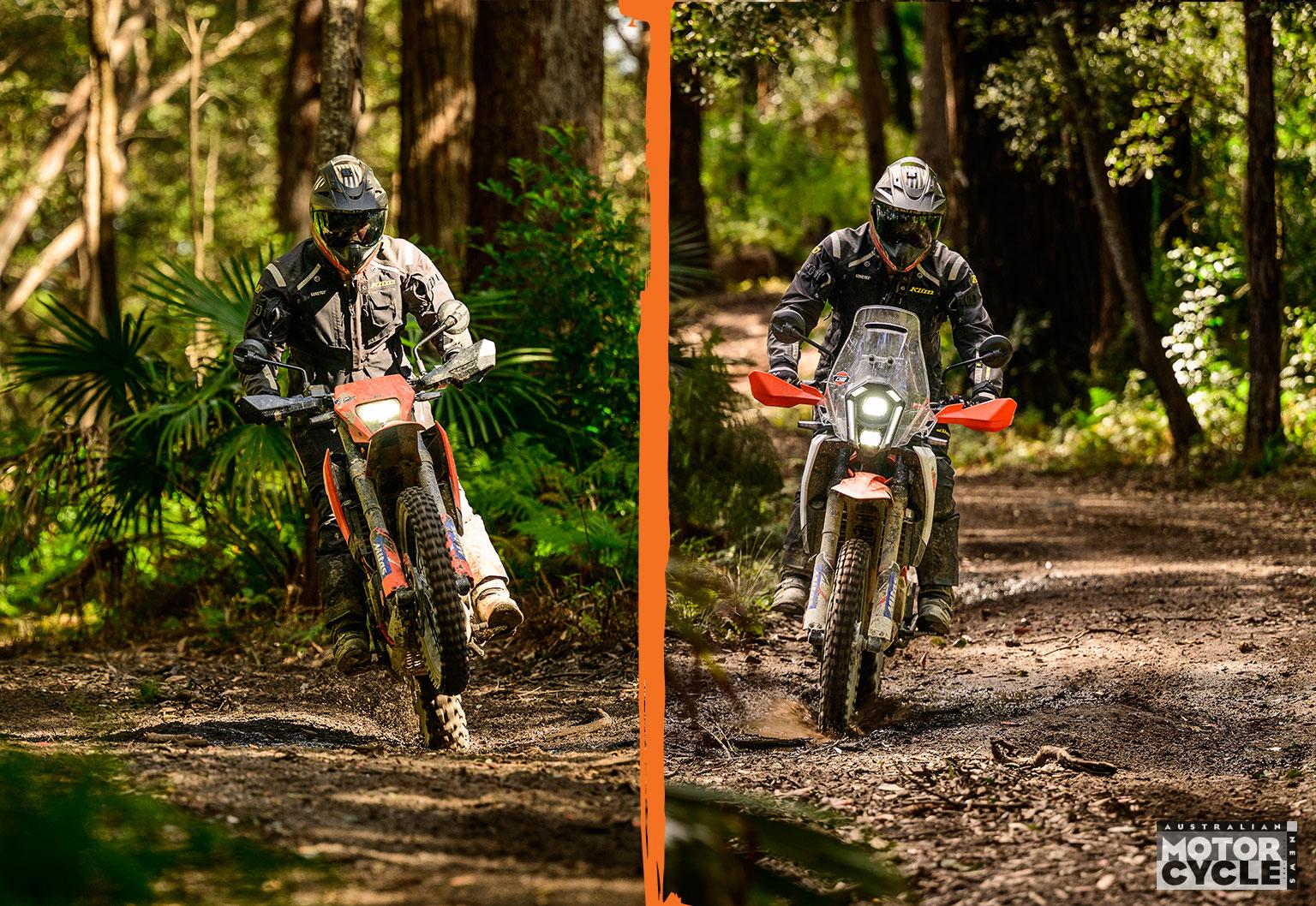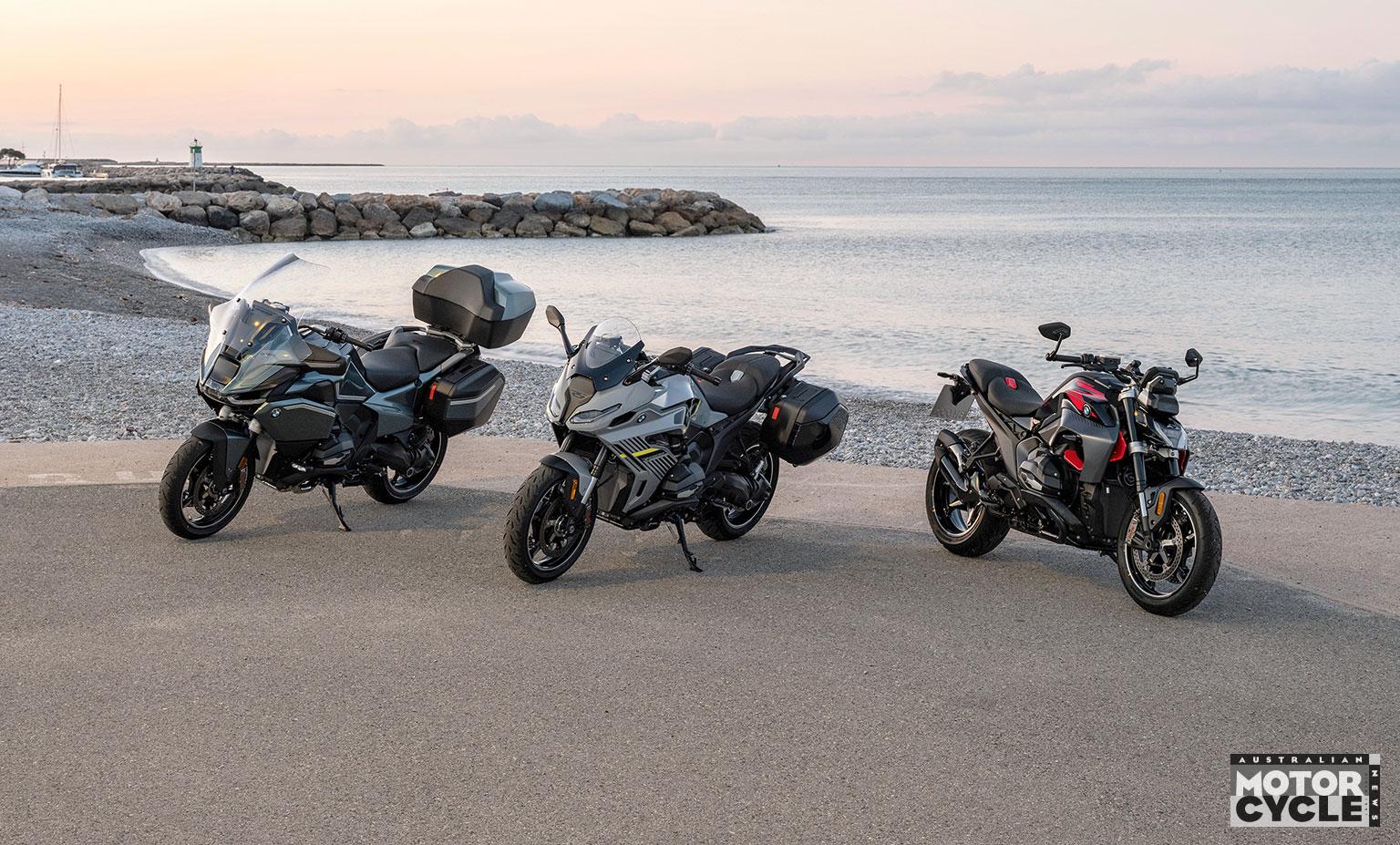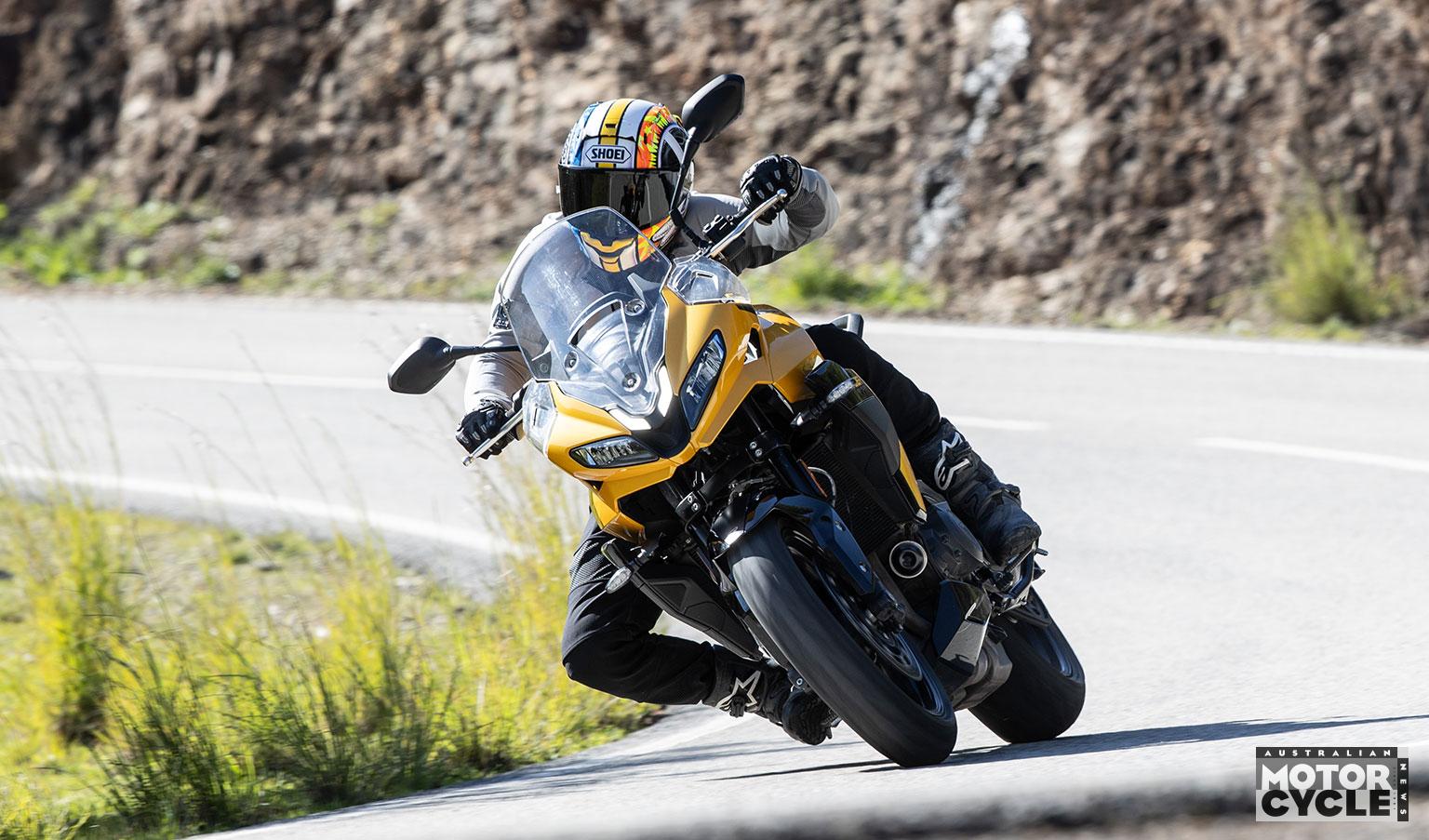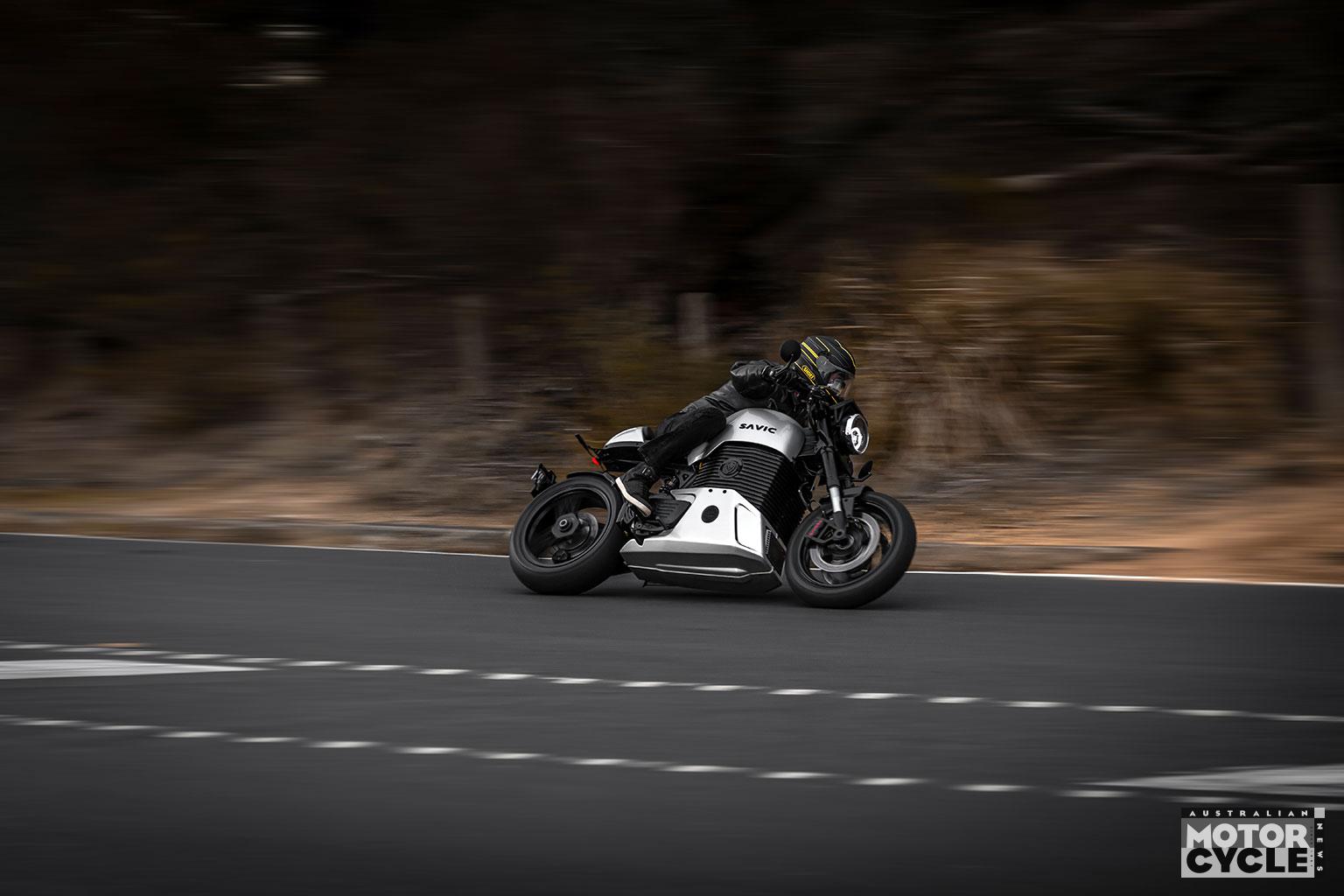An all-new engine and monocoque frame signal big changes for the Ducati Multistrada V2 crossover
Ducati Corse may be hogging the headlines with its near-total domination of MotoGP, but away from the limelight something no less exciting has been brewing in the Italian marque’s engine department in Borgo Panigale – namely, an all-new 890cc V-twin, which we see here for the first time in the radically overhauled 2025 Multistrada V2.
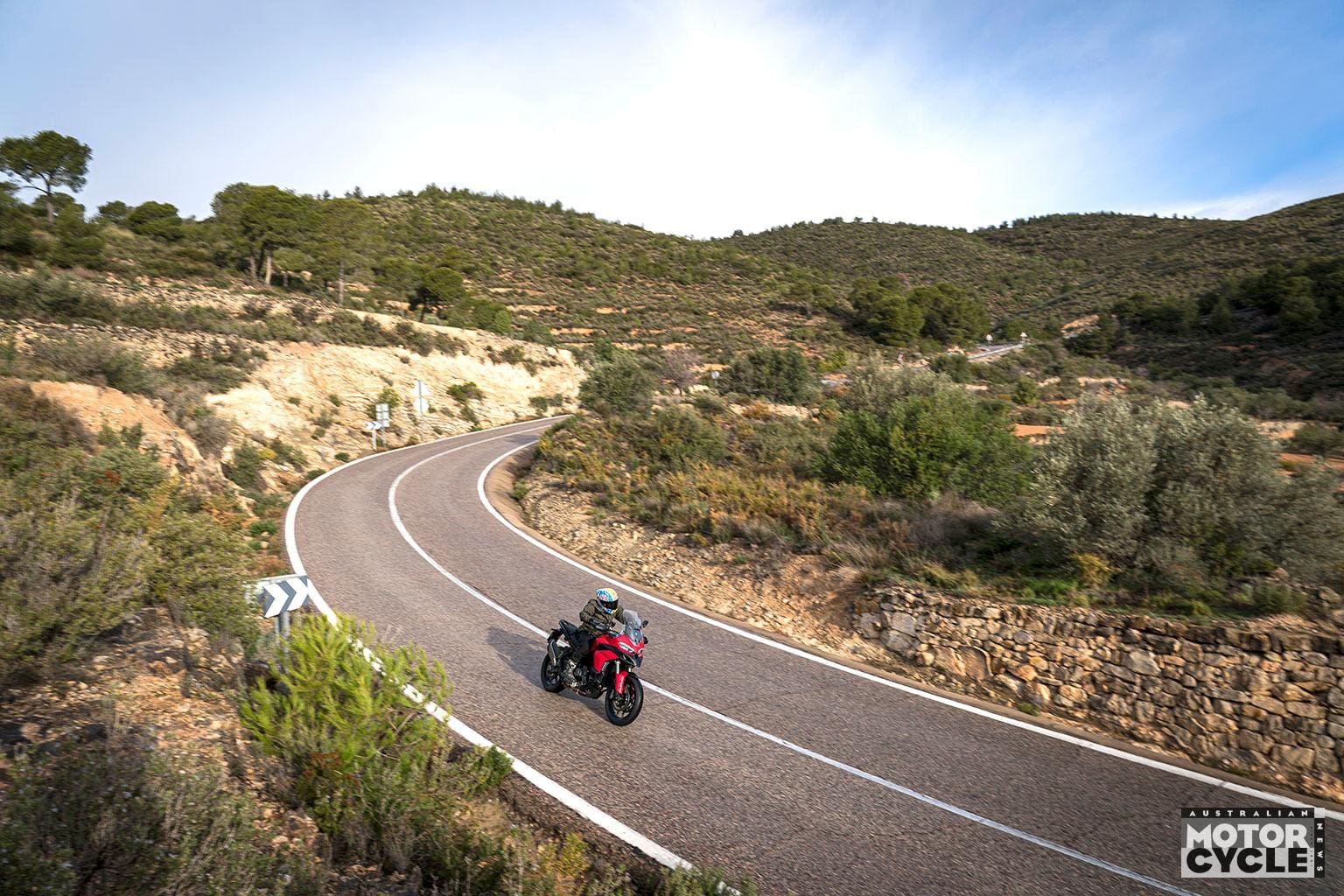
At a claimed 54.9kg, Ducati say it is their lightest V2 yet. Peak power is up, while service intervals – 15,000km or 24 months for minor services and 30,000km for a valve inspection – remain the same. Ducati purists might baulk, but the Italians have gone against tradition by ditching the desmodromic valve timing used in the outgoing Testastretta V2 in favour of conventional chain-driven cams and spring-loaded return valves.
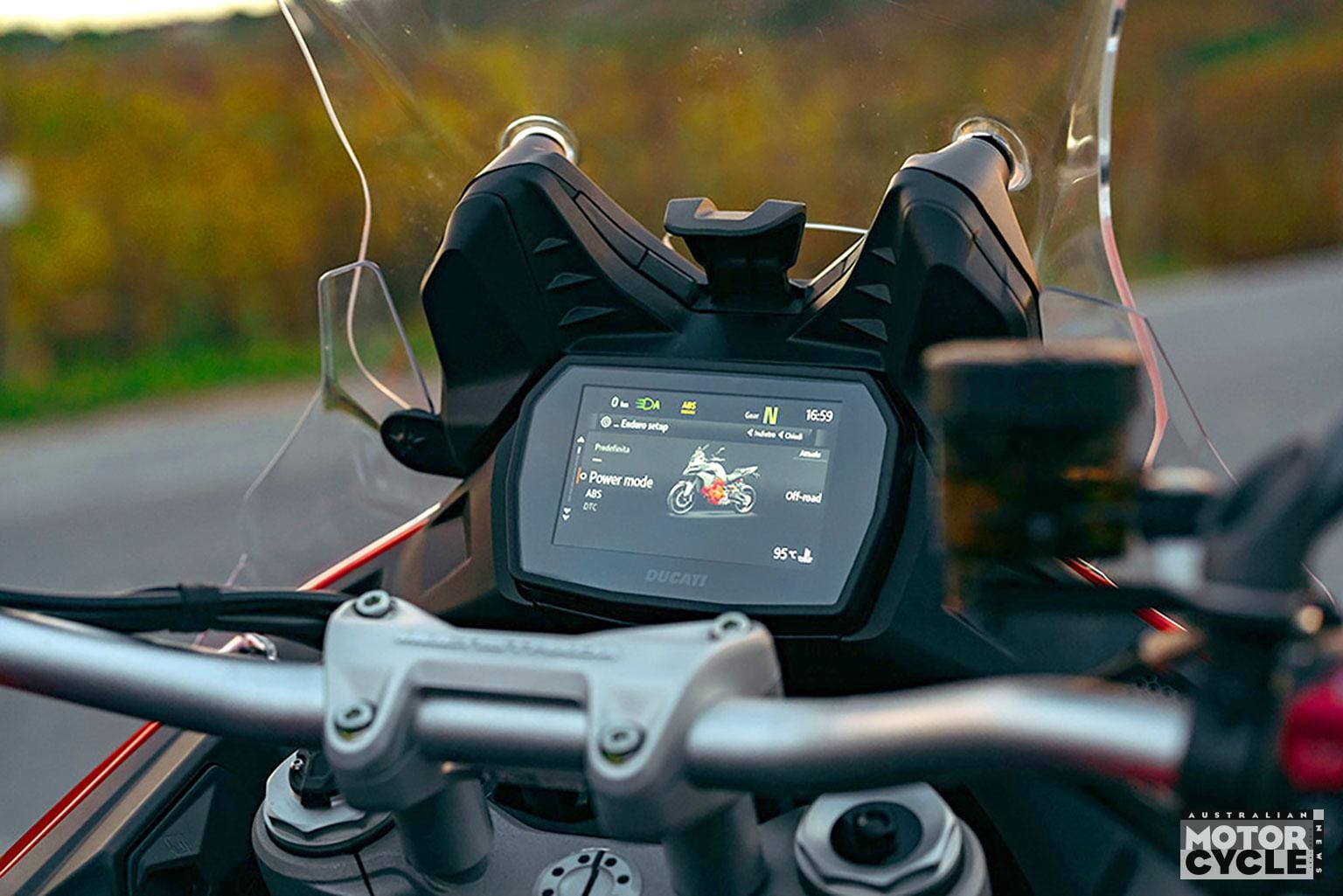
It’s not often that a ‘new’ bike can genuinely be described as completely new, but there is very little of the 2025 Multistrada that can be found on previous models. The chassis now features a compact aluminium monocoque frame, which uses the V2 as a stressed member and is much lighter than before, and an attractive trellis subframe that nods to Ducati’s historic attachment to triangulated steel tubing.
Suspension on the S option is by electronically controlled Skyhook units complete with a new minimum pre-load seat-lowering function, while the cheaper non-S uses a manually adjustable Marzocchi fork and rear shock.
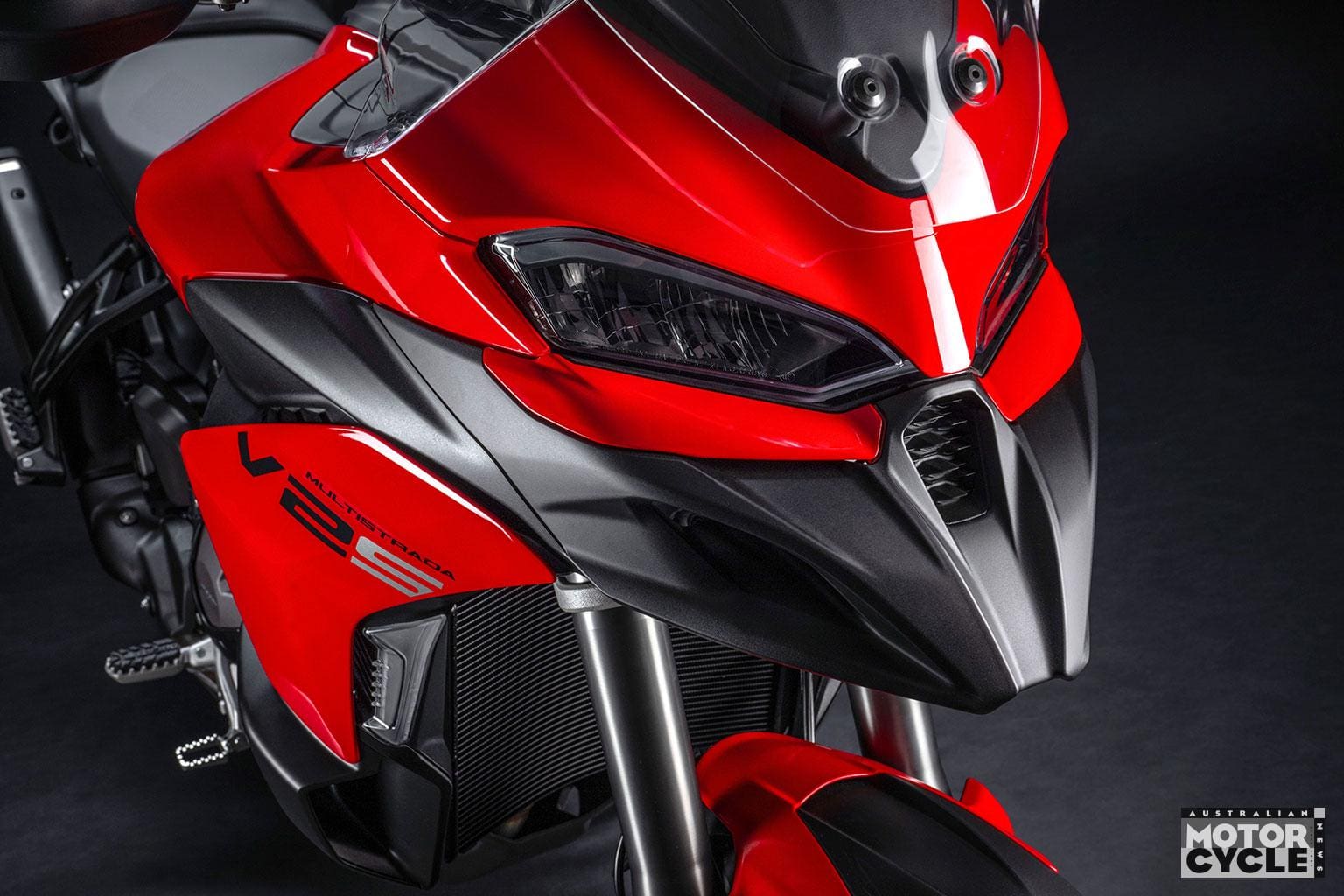
The wheels remain at 19-inch diameter (front) and 17-inch (rear) but are lighter. The bodywork is more compact, more integrated and designed to flow air to the rider more effectively. There’s also a new TFT display, new switchgear, a new and adjustable seat between 830mm and 850mm… Only the quality Brembo brakes survive from the existing Multi. At 202kg, the new S version is a staggering 18kg lighter than before. What was the old bike made of – granite?
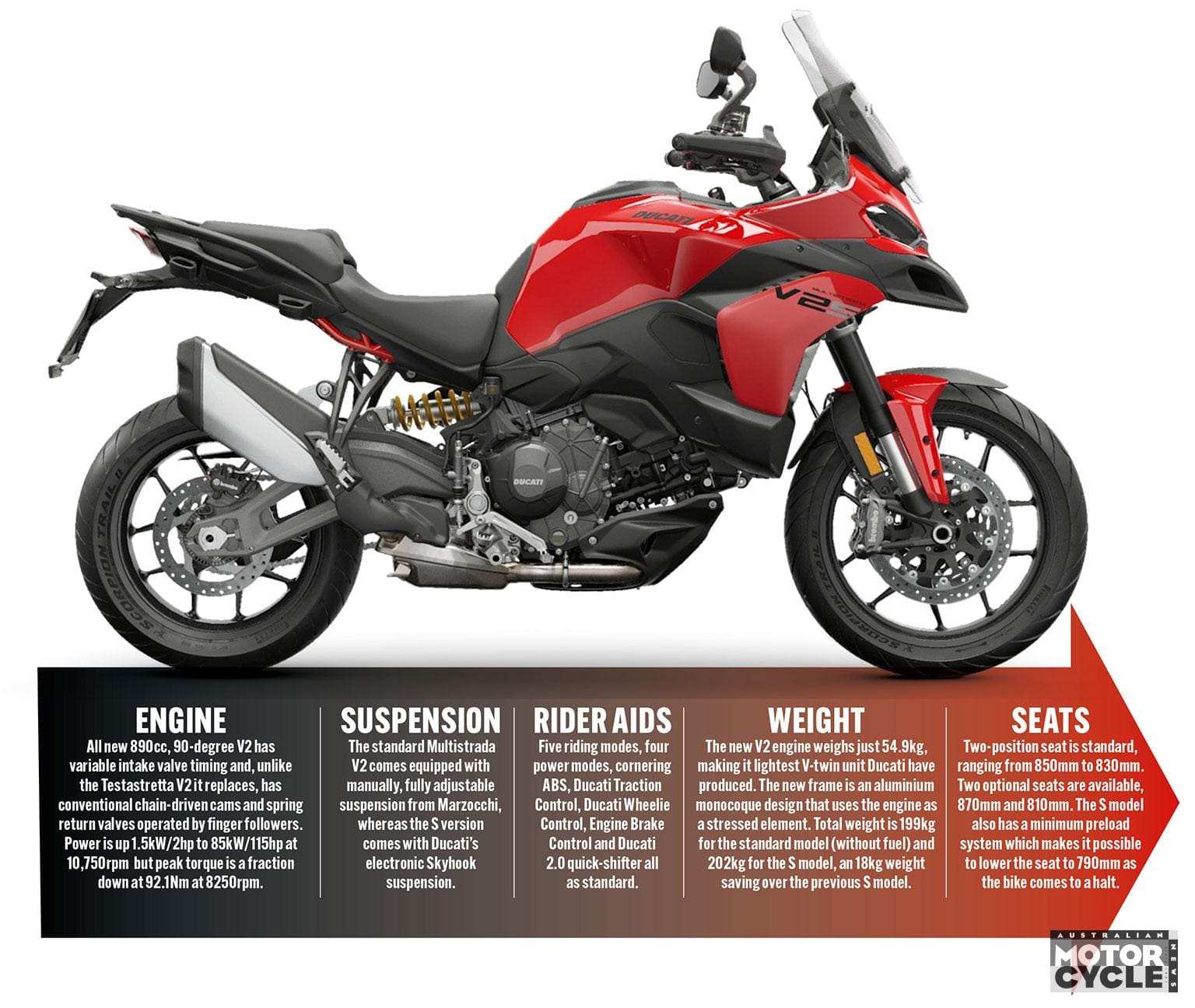
As you’d expect from Ducati, the 2025 model arrives with a plethora of refined electronic goodies. There are five riding modes – Sport, Touring, Urban, Enduro and an all-new Wet. Each mode adopts four power modes (high, medium, low and a new off-road power mode), along with a specific level of rider aid intervention and suspension settings (dynamic, comfort, low grip and off-road). You can also set the rider aids to your desired level. Ducati Traction Control and Wheelie Control have eight levels, while Engine Brake Control and the cornering (lean-sensitive) ABS have three levels.
There are no heated grips or centrestand, but cruise control and a quickshifter do come as standard. We headed to a windy, cold and sometimes wet Valencia in Spain to see if the new Multi V2 can live up to the hype.
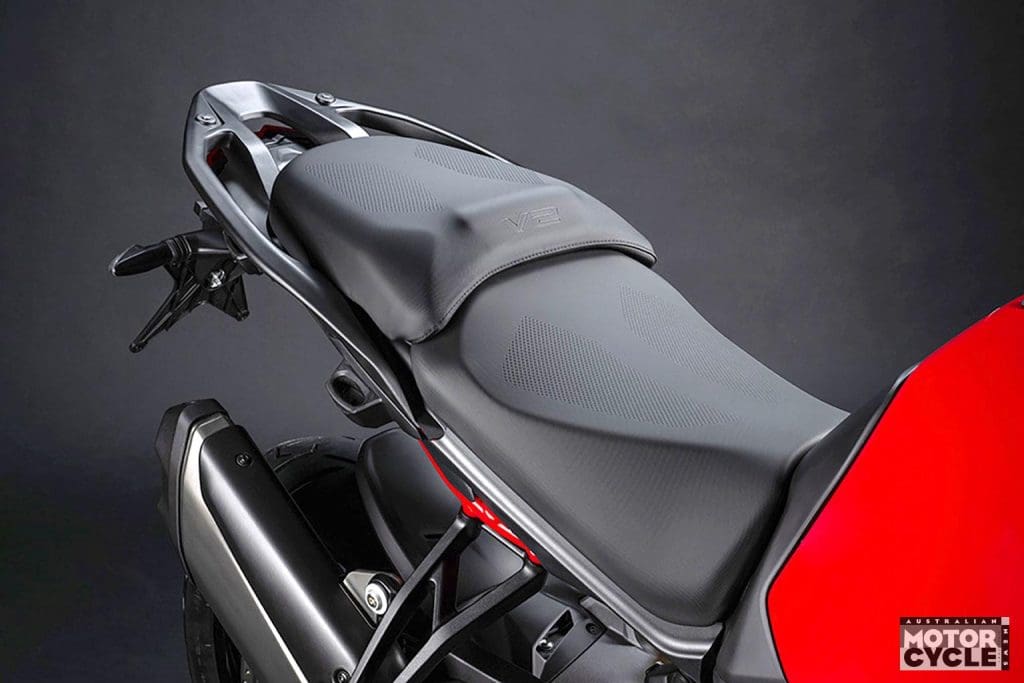
The ride
This is a hugely important new model, not only for the Multistrada brand but also for Ducati. Its new 890cc V2 platform, which replaces the Testastretta V2, will also be housed in a Streetfighter V2 and Panigale V2 – so very much needs to make a strong first impression with the Multi.
At 54.9kg, the new engine is 5.8kg lighter than the Testastretta. Peak power is up now to 85kW (115hp) at 10,750rpm, but peak torque is a fraction down at 92Nm at 8250rpm. Ducati claims 75 per cent of the V2’s torque is in play from as little as 3500rpm and remains until 11,000rpm. As impressive as those figures are, the smaller 890cc V2 has to rev harder than the larger 937cc Testastretta to make its numbers. Peak power arrives 1,50rpm later than the Testastretta’s 9000rpm, while peak torque arrives 1500rpm later than the older engine’s 6750rpm.
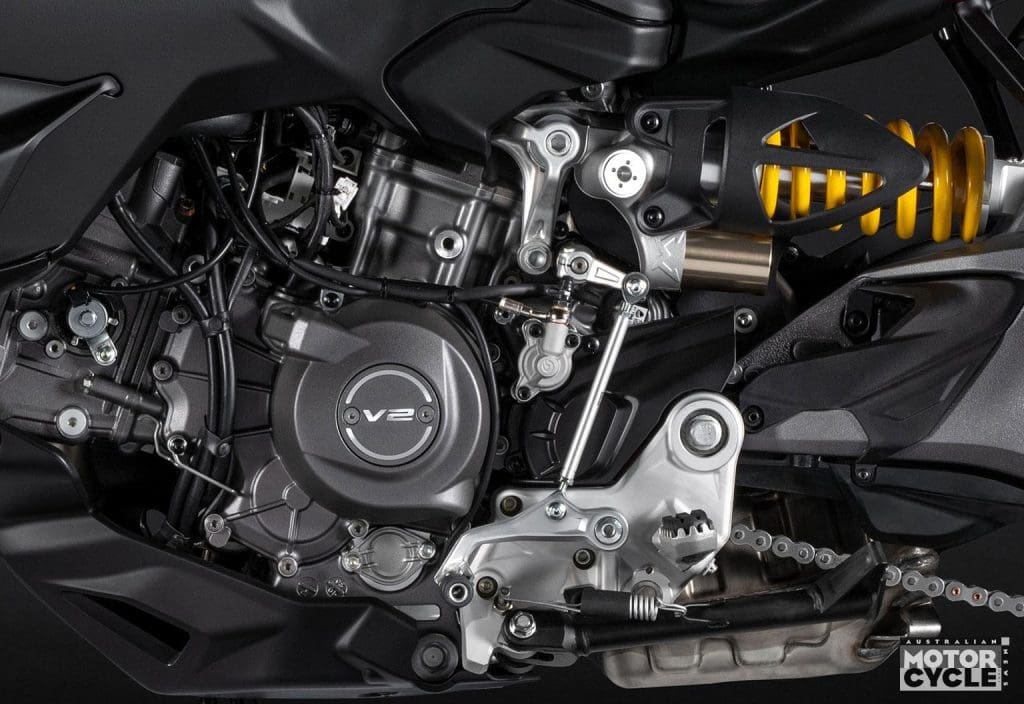
So we have a lighter, slightly more revvy engine that produces more power and just a fraction less torque, plus a lighter chassis – and first impressions at low speeds are extremely positive. The fuelling is absolutely on point, while a heavier flywheel and lower first gear make it almost impossible to stall; as you release the clutch the revs raise slightly. At town speeds, the V2 is also super smooth and totally unrelatable to the lumpy Ducati V-twins of yore. The Testastretta V2 is itself an excellent engine in town but, with its immaculate throttle response, the silky 890cc unit is a step ahead, particularly in Wet and Urban modes.
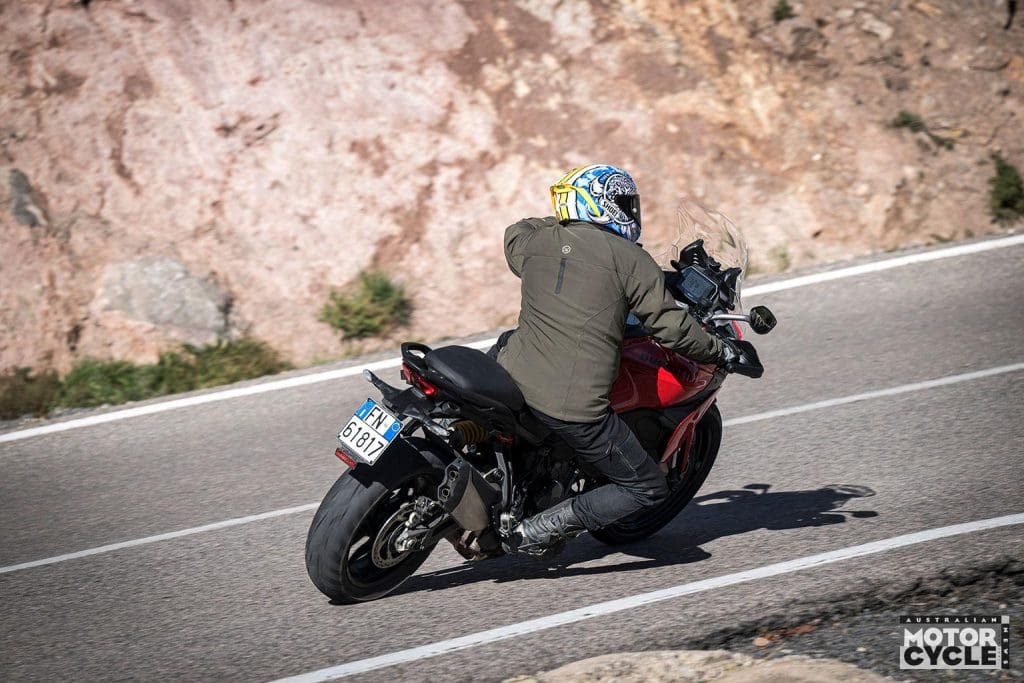
From just 2000rpm it pulls cleanly and feels crisp, but for some of the test I deliberately rode in a tall gear to get a feel for the low-down power and torque, and there is no doubt the new V2 has lost some urge between 2000rpm and 4000rpm. It certainly can’t match the basement grunt of larger bikes like Honda’s similarly priced Africa Twin, and it will be interesting to see how it goes in a side-by-side acceleration test against the current Multistrada V2.
From around 3500rpm, though, the new bike slips into its sweet spot. From here on it pulls with free-revving urgency to its 10,750rpm peak – and beyond, if you want to be brutal. Once we had left Valencia behind and headed into the mountains, it was easy to make full use of the new V2’s flexibility, experimenting with its easily accessed multiple riding modes while exploiting the drive of the midrange and working the effortless and smooth quickshifter.
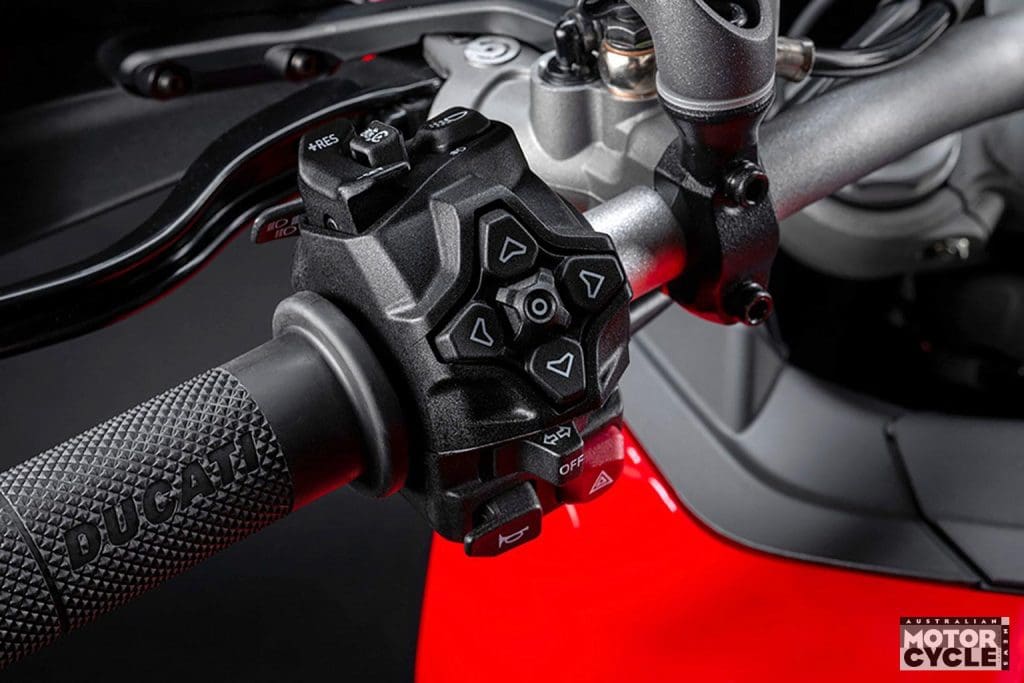
The V2 revs fluently and will easily loft the front with a whiff of clutch once the DWC is removed. Alternatively, you can ride that smooth and wide midrange and still have a thoroughly spirited ride, galloping past cars and enjoying the bike’s natural flow. But the fun is not just down to the new engine, because that new, much lighter chassis and redrawn geometry deliver an excellent ride. The handling, stability and tracking on those 19-inch/17-inch wheels are still unmistakably Multistrada, but there’s a freshness to the way it steers. It’s neutral, light and incredibly easy to hussle through the hills.
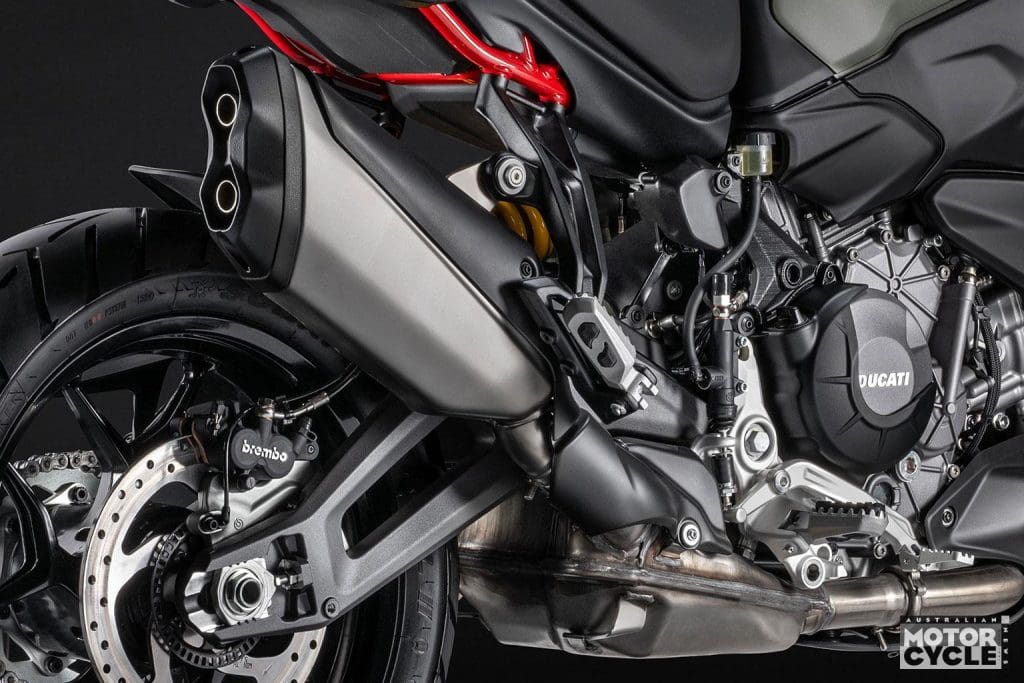
BETTER WETTER
In the morning it was very cold and wet, and I wished Ducati had fitted the optional heated grips. Despite the grim conditions, the Pirelli Scorpion Trail II rubber worked well. I initially opted for Wet mode, which drops the power to 71kW (95hp) and sets the Skyhook suspension to ‘low grip’ while turning up the lean-sensitive rider aids. When you don’t know the road or conditions, this is perfect, especially for inexperienced riders. But even in the wet, I actually preferred the more engaging Touring mode, with its ‘medium’ power setting (that still delivers a 86kW/115hp peak). For me, Wet mode is more suitable for near-freezing conditions or slimy cobbles – an option to keep you safe in the worst of riding environments.
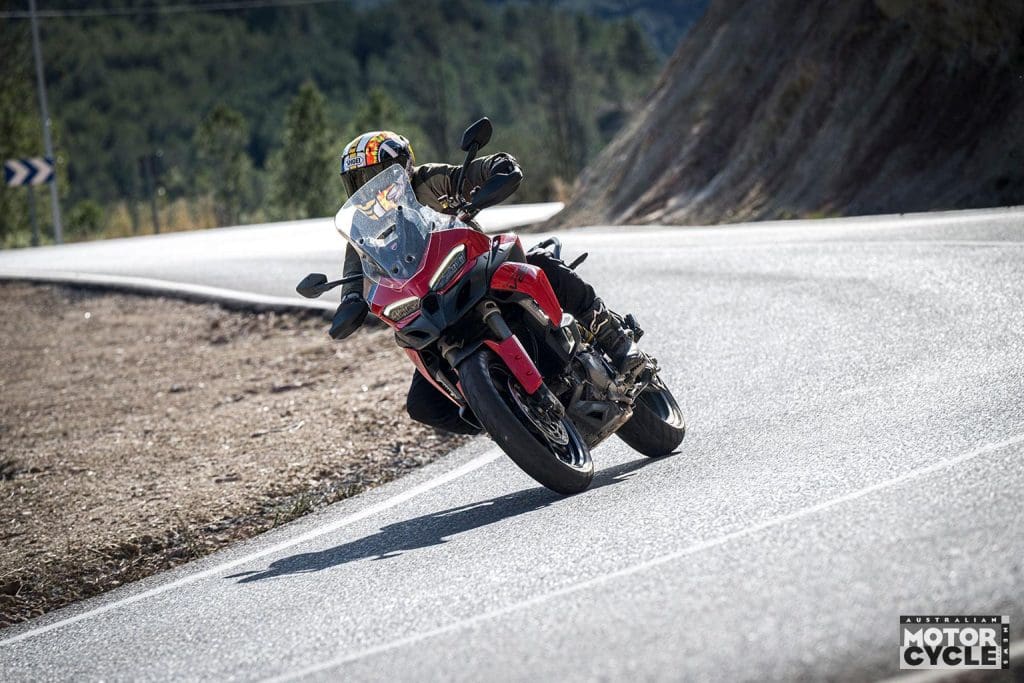
Before lunch, I spent the majority of time in Touring. Don’t be misled: despite the Skyhook suspension being set to comfort, this does not mean the new Multi can’t be ridden hard. The Marzocchi units react to road imperfections in a way that seems to iron flat the road surface yet remain taut enough to encourage sporty riding. Truly, the days of wallowing sports tourers are long gone. You can feel the suspension working, you can feel the grip from the Pirelli rubber, which feeds you the confidence to tackle an unfamiliar section of road at pace. The lightness and flickability of the new Multi really shines and, despite Ducati opting to retain a 19-inch front wheel for easier off-road riding, the 2025 Multistrada V2 works even better on asphalt than the highly acclaimed current model.
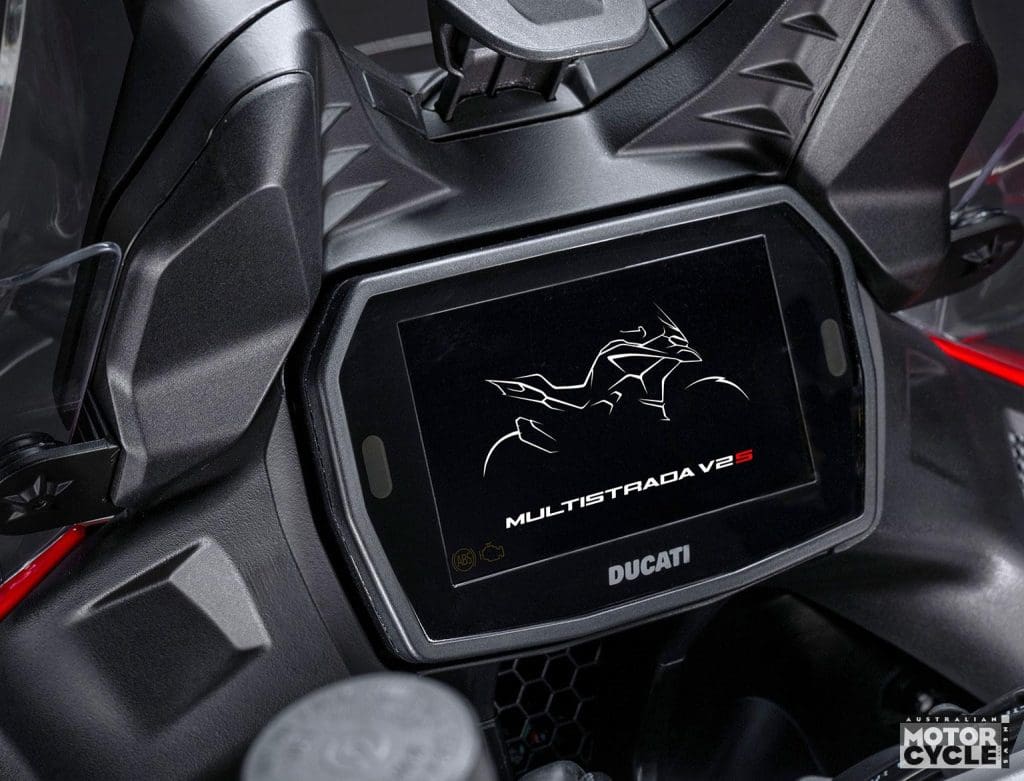
At lunch I made a few more tweaks. I put the S into Sport mode with the dynamic suspension setting and opted to switch off the DWC and DTC for a purer experience. Sure, most owners won’t be interested in riding aggressively, but it was revealing to discover just how hard this bike can be pushed.
A middleweight adventure bike should not be overly easy to ride at pace –the rider should expect to do some work – but the V2 is. That neutral steering and new-found lightness make it a delight to turn. Changes of direction are executed with absolute efficiency. In the late afternoon amid perfect riding conditions, it powered down a deserted stretch of tortuous road without a hint of drama. I don’t think any adventure bike in this class could match the ease of use and handling of the new Multi V2. Even when ridden hard it takes very little from its pilot.
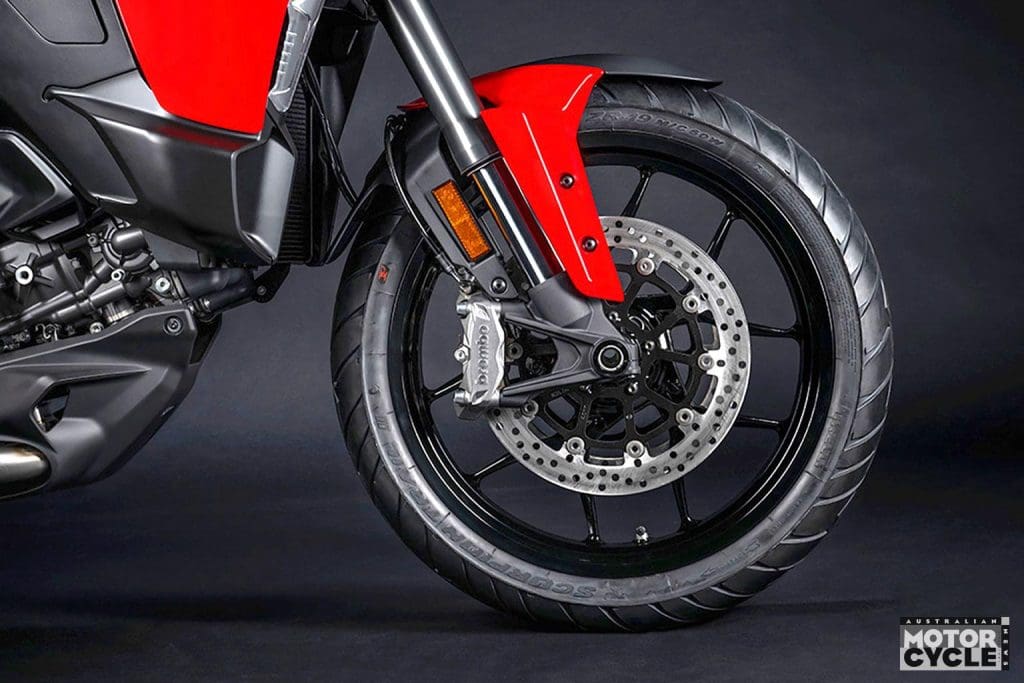
The brakes remain unchanged, with the familiar Brembo monobloc four piston calipers and 320mm discs retained up front and a 265mm disc on the rear. There are 18kg fewer to haul up, though, and better suspension support than before, too, so I was expecting the stoppers to be slightly sharper than they were on test. Usually, combining Ducati and Brembo results in eye-watering, race-bike levels of braking, but here are softer, feel more progressive and have more travel at the lever. This might be down to new pads and discs, or maybe Ducati have deliberately softened the set-up as the Multi is designed for touring, not track days.
Either way, I was having so much fun on the 2025 Multistrada V2 that I almost forgot to think about everyday riding issues such as comfort. On that I can say that I reached the end of a long day in the (height-adjustable) saddle without noticing any aches or numbness, but also that we need to add more miles on less entertaining roads to get the full picture. The new, sleeker, more compact and more integrated bodywork has neat little wind deflectors on the side that look like aero wings but are in fact designed to upwash fresh air to the rider in hot conditions – a thoroughly welcome detail for summer riding but perhaps not so advantageous in winter.
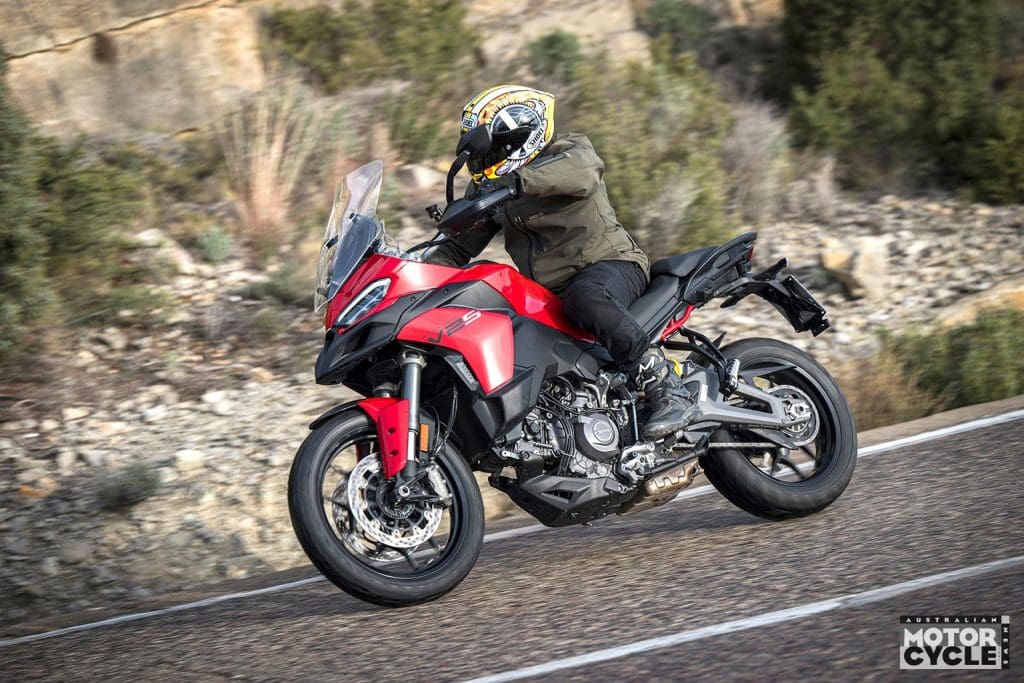
Given the price of the V2 S, the screen should arguably be electronically adjustable but, fully upright, wind protection appeared to be good on the short stint of riding we managed with the standard cruise control activated. Setting the cruise is simple enough – there’s no radar here – but I wouldn’t say the new switchgear is completely intuitive. Maybe I was thrown slightly by being so familiar with the switches and buttons on the current V4 S, which are similar but not quite the same…
The three different display options on the five-inch TFT dash are Road, Road Pro and Rally. I really like the first two, which are crisp with a clear hierarchy of information, but found Rally a little complicated. While I’m having a gripe, the minimum preload function, which drops the seat height for shorter riders as you come to a halt, is a nice touch, but the button is on the right-hand cluster and the same side as the front brake. As a (170cm) short rider, I often wanted to reduce the seat height when coming to a stop but found it awkward to press the button and brake at the same time.
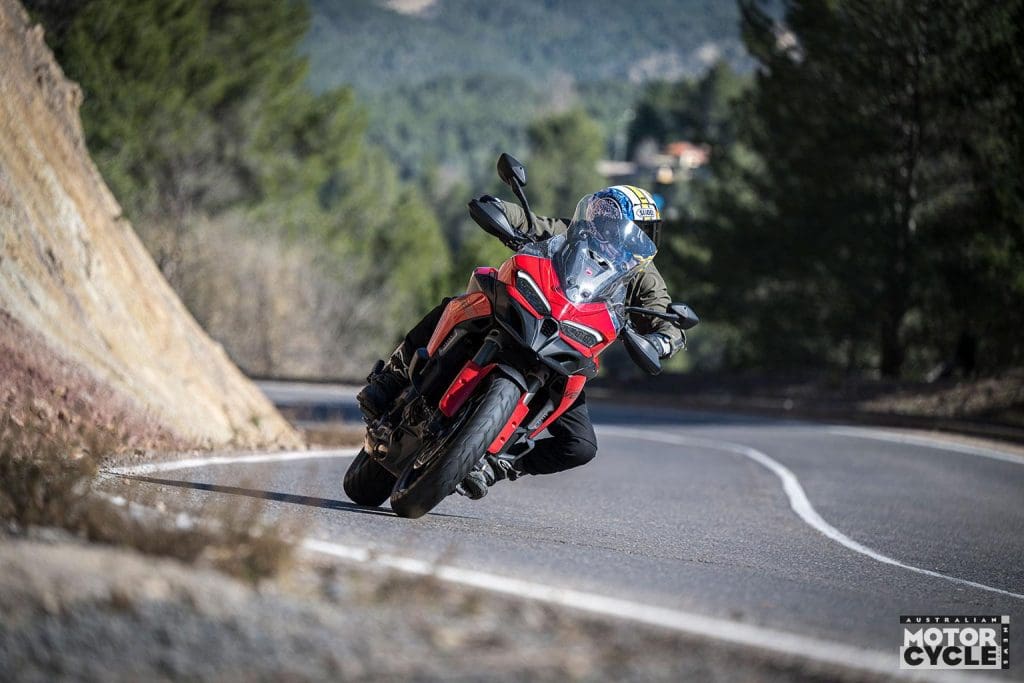
That said, I didn’t have a problem getting two feet securely on the ground, even with the adjustable seat on its higher setting of 850mm. Should you wish, it takes just 30 seconds to remove the seat, make one small alteration and drop it to 830mm. There are optional lower (810mm) and higher (870mm) seats available, along with a long, long list of factory standard accessories. Highlights include a USB socket next to the dash, Ducati Brake Light EVO, and a ‘coming home’ function that keeps the low beam active for a short time after the ignition is switched off. There is even a 4Ever Ducati roadside assistance package, a four-year warranty and four-year road assistance with over 800 official dealers in 90 countries.
Verdict
Despite Ducati providing a full day of testing, we still have a few unanswered questions. What will the new Multistrada V2 be like on the trail, over longer distances, on the freeway? But initial impressions are positive, and cruise control comes as standard.
We can categorically say that the handling is impressive, especially for a middleweight adventure bike with off-road capabilities. In terms of lightness, flickability and its sheer ease to ride at pace, the Multi’s chassis and suspension are class leading. The new V2 engine is equally dynamic, has a strong mid-range plus more top-end power than found in similar capacity competition. Combine that class-leading handling with class-leading performance and you have a winning Ducati formula.

However, Multistradas are not just about who can reach the destination the fastest or with the biggest smile. The new V2 has top-of-the-line riding modes and rider aids that are relatively easy to understand and use, and we can’t ignore the quality finish, looks and desirability. While other manufacturers look to produce their machines outside their home territories to save on cost, Ducati maintain high levels of production at home in Italy.
The new Multi has lost a little drive below 4000rpm, although only a back- to-back test will tell us for sure how much this matters, and there are a couple of niggles in the shape of hard-to-use minimum preload function and absence of heated grips, which should come as standard. Price can’t be ignored, either. $26,100 for the standard model and $29,200 for the tested S model not only place the Ducati above the middleweight competition – KTM 890 Adventure: $24,795, Triumph Tiger GT Pro, $24,790 – but also edges it towards larger capacity bikes like Honda’s CRF1100L Africa Twin ES at $26,498. Even BMW’s all-new, base R 1300 GS is comparable on price at $29,900. Both the Honda and BMW are much heavier and, for some riders, will be more intimidating, while the similar KTM and Triumph don’t come with electronic suspension like the V2 S.
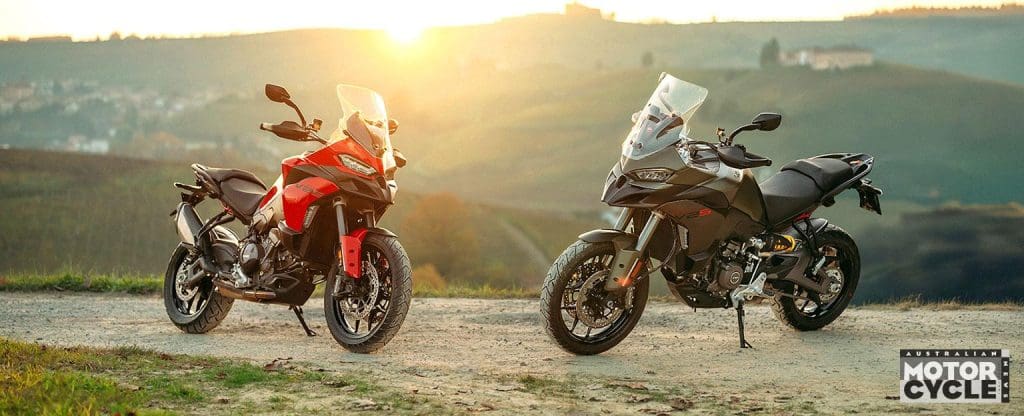
The completely new Multistrada V2 is a big step over the previous model, which remains excellent if slightly dated: lighter, sharper handling, more intrinsic pace, way more fun and retaining its practicality and comfort. But it will cost you.
PROS – A complete redesign with new engine sets new standards for this middleweight market segment.
CONS – Priced high. Suspension-dropping control is too close to the brake lever when stopping. Heat grips not standard.
Competition
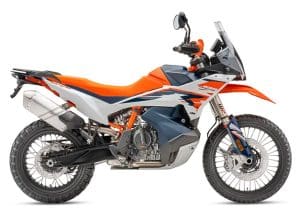
KTM 890 Adventure – $24,795
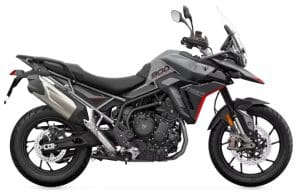
Triumph Tiger GT PRO – $24,790
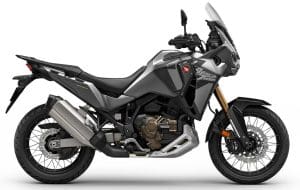
Honda’s CRF1100L Africa Twin ES – $26,498
SPECIFICATIONS

ENGINE
Capacity 890cc
Type Water-cooled, 4 valves per cylinder four-stroke, 90-degree V2
Bore stroke 96mm x 61.5mm
Compression ratio 13.1:1
Fuel system Electronic fuel injection with ride-by-wire, 52mm throttle bodies
Transmission Six-speed Quick Shift up/down Gen 2
Clutch Hydraulically-operated slipper and self-servo wet multiplate.
Final Chain drive
PERFORMANCE
Power 85kw (115hp) @ 10,750rpm (claimed)
Torque 92.1Nm @ 8250 rpm (claimed)
Top speed 250km/h (est)
Fuel consumption 5.9L/100km (tested)
ELECTRONICS
Type Bosch
Rider aids: Riding modes (see below), Power Modes, Bosch Cornering ABS. Ducati Traction Control (DTC), Ducati Wheelie Control (DWC), Engine Brake Control (EBC)
Riding Modes: Sport, Touring, Urban, Enduro, Wet
Frame Monocoque aluminium
Rake 24.3°
Trail 105.5mm
Wheelbase 1572.5mm
SUSPENSION
Type Marzocchi
Front 45mm, fully adjustable USD, electronic Skyhook suspension 170mm travel
Rear Single shock, electronic Skyhook suspension 170mm travel
WHEELS & BRAKES
Wheels Light alloy cast
Front 3in x 19in
Rear 4.5in x 17in
Tyres Pirelli Scorpion Trail II
Front 120/70 ZR 19
Rear 170/60 ZR 17
Brakes Bosch cornering ABS
Front: 320mm discs, radially mounted Brembo monobloc 4-piston calipers
Rear 265mm disc, Brembo two-piston caliper
DIMENSIONS
Weight 202kg (wet no fuel)
Seat height 830-850mm (adjustable)
Fuel capacity 19L
SERVICING & WARRANTY
Servicing First: 15,000km, 12 months Valve check 30,000km
Warranty 24 months unlimited mileage.
BUSINESS END
Price $29,200 for the V2 S; $26,100 for the base V2.
Colour options Ducati Red or Storm Green (V2 S)
CONTACT
